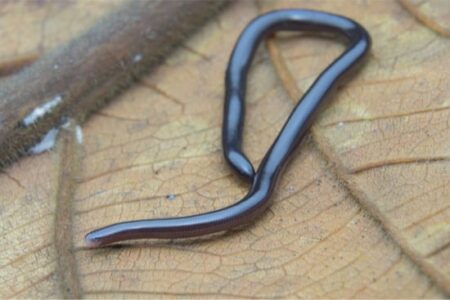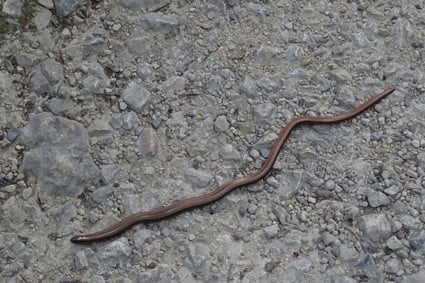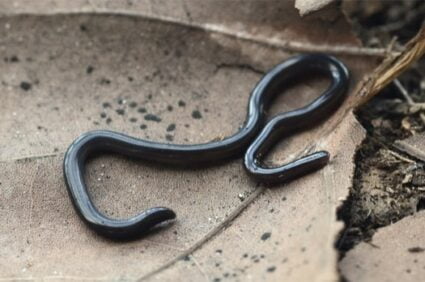Snakes and worms share some characteristics. They have long bodies, can appear brown or gray in color, and may not have an obvious head end or tail end. Because of these similarities, you may think that baby snakes would look a lot like earthworms.
Some mistake the Brahminy blind snake for an earthworm, but they have several differences. Baby snakes are bigger, have different colors and patterns, don’t have segmented bodies, and don’t move in the same way. They have visible eyes, scales, and mouths while worms don’t.
There are many differences between baby snakes and earthworms which means that you can easily tell them apart. You don’t need a microscope or extensive training to spot these differences.
Do Baby Snakes Look Like Worms?
Each of the differences is easy enough to spot on its own. But, in combination with the rest, you won’t mistake a worm with a baby snake.
The only exception is the Brahminy blind snake. Also known as the flowerpot snake, this snake is much smaller and less developed than other species. It is gray in color and the same size as an earthworm, which can lead to confusion over what it is. But the below points can still help you tell.
Size
Certain snake species are bigger than others, and this applies to juveniles as it does to adults. But even in the smallest of native U.S. snakes, a hatchling isn’t as small as a regular earthworm.
A corn snake hatchling is between 8 and 12 inches long. An eastern diamondback rattlesnake is even bigger at 15 inches long. There are snakes that are the size of worms, but the majority of species are much bigger.
In addition, snakes are wider around the middle than worms. Snakes have organs like other vertebrates: lungs, livers, hearts, brains, etc. In an animal as long as a snake, these organs have to be bigger.
Segmented Bodies
Common earthworms have segmented bodies. These worms belong to a ‘phylum’ called the Annelids, a ‘phylum’ being a large grouping of many animal species. Each segment contains muscles which can be moved independently, which is key to the worm’s movement.
Snakes don’t have segmented bodies. To be clear, they have sections to their bodies: a head end, a core torso, and a tail end. But these sections aren’t delineated by obvious rings like they are in a worm’s body. And a worm has far more than only three segments: it has dozens.
Move Differently
Earthworms have a distinctive way of moving. They are adapted to living underground, which is where they spend their time when it’s not raining, and these adaptations have led to the unique way they move.
They move by using two different sets of muscles. The first kind is rings that are contained within each segment. These expand and contract, which is how the worm becomes longer and shorter. They also have muscles that run from ‘head’ to ‘toe’.

The worm will move by anchoring its ‘head’ in place before contracting the rest of its body and pulling itself forward. The snake becomes shorter and shorter. It then releases its head and lengthens again, finding an anchor point further forward.
It’s aided in this by tiny hairs it has along the side of its body called setae. While not all worm species are the same size or shape, this is the way they all move. Snakes don’t move like this. There are 4 ways they can, which are:
- Concertina. The snake anchors its head and pulls itself forward, but its body doesn’t contract. Instead, it bunches up like a concertina.
- Serpentine. The snake moves forward with its head going from side to side.
- Sidewinding. Similar to the concertina movement, but sideways.
- Caterpillar. The same way that a caterpillar moves.
Concertina and serpentine are the most common methods of movement. These are instantly recognizable because the snake doesn’t shorten its body as a worm does. A Brahminy blind snake moves with serpentine motion, which is instantly recognizable compared to similar-sized worms.
Scales
Another difference is that even the smallest of baby snakes have scales. They don’t hatch from their eggs without scales, like certain animals don’t have fur or feathers while juvenile. The only difference is that the scales are small, albeit still visible.
These scales are, biologically, a modified form of fur. A paper in the journal Zoology states that these scales are made of keratin, the same material that fur and nails/claws are made from. Snakes do have skin, but it’s underneath their scales, like the skin is underneath fur or feathers.
Earthworms don’t have scales, or anything that looks like scales. Instead, they have soft skin that is easily punctured or scratched. They haven’t evolved scales like fish and reptiles have, even though they would be beneficial to the worm.
This is the key difference between earthworms and Brahminy blind snakes. Despite being so small, these snakes still have scales. They are visible to the naked eye if you look closely.
Eyes
Worms don’t have eyes in the same way that many invertebrate animals do. They have small clusters of cells that can sense light, but not movement and detail like a person’s eyes can. The main use of these ‘eyes’ is to tell whether the worm is above or below ground. These clusters of cells aren’t visible to the naked eye.
Snakes, by contrast, do have eyes. All snake species do, although the size and shape of the eyes do differ. Snakes have pupils, which can either be in the shape of slits or circles. They function the same as the eyes of people.
A snake’s vision isn’t as good as a person, but it’s certainly better than that of a worm. These eyes are large enough to be visible, even in baby snakes. In the Brahminy blind snake, the eyes are two small dots at the head end of the body. They are difficult to see, but definitely there.
Mouths
Baby snakes are vertebrates, so despite being an unusual shape, they still follow a regular body design for a land animal. This means they have all the normal things that vertebrates have, including mouths to eat with.
These mouths are visible in the snakes’ heads. You can see the mouth open wide when the snake eats its prey. Inside the mouth is the snake’s forked tongue. The Royal Society states that a snake’s tongue helps it smell pheromones in the air. It also has fangs that vary in length between species.
Worms have mouths because like other animals, they need to eat. However, they are small and kept hidden. These are at the front of the worm’s body. Above the mouth is the prostomium, which acts as a large lip and covers the mouth when not in use.
According to the Journal of Morphology, these mouths must function like larger animals’ mouths because they have large numbers of chemoreceptors near them. These allow the worms to tell between things that are suitable food and things that aren’t.
The digestive tract runs directly from the mouth through the worm’s body to the anus, without coiling. But whatever the case, the mouth is small and covered so it is difficult to see. A snake’s mouth is much more highly visible.

Colors
Earthworms are typically brown or gray in color. The reason for this is that they live in the soil, so it’s advantageous for them to be the same color as the ground (gray like rock, or brown like soil). This stops them from being eaten by predators as often.
Baby snakes can also be brown or gray. But they can be many more colors besides, including deep reds, blacks, oranges, and more. What’s even more noticeable is that snakes have different patterns, while worms have no pattern. So, for example:
- Corn snakes are orange with black lines around red saddle-like markings.
- Garter snakes have a black, brown or green background color almost like an earthworm. But they have yellow stripes running from head to tail.
- Diamondback rattlesnakes are tan or brown, again like worms. But they have diamond patterns running down their backs.
These patterns are formed by the snake’s scales. Each scale acts as a pixel of a different color. While the pattern and color of juvenile snakes may be different from that of the adult form, this still distinguishes them from worms.
Bones
This is a major difference, but one that’s more difficult to spot from the outside. Snakes are vertebrates, which means that they have bones. These are bones like other animals have, e.g. vertebrae (hence ‘vertebrate’) and ribs. Some snake species even have the remnants of leg bones.
Worms don’t have any bones. They’re invertebrates. You can spot this difference in the way that snakes and worms move:
- Worms can bend back entirely on themselves
- Worms can coil tightly in a way that they couldn’t if they had bones
Also, snakes have an obvious head shape, which they could only have if they had skulls. You can also feel the difference if you have a worm or a snake in your hand. You can squash a worm, but not a snake. You can also feel a snake’s ribs if you hold it around the middle.
The Brahminy blind snake has bones, too. This means that it doesn’t move like a worm. It’s less curly, wiggly and mobile. They also aren’t as squishy because they have solid bodies.
If you learn to spot each of these differences, you can soon easily tell apart a baby snake from a worm.


What does the worm snack eat because I have one that is 10mm what should I feed it